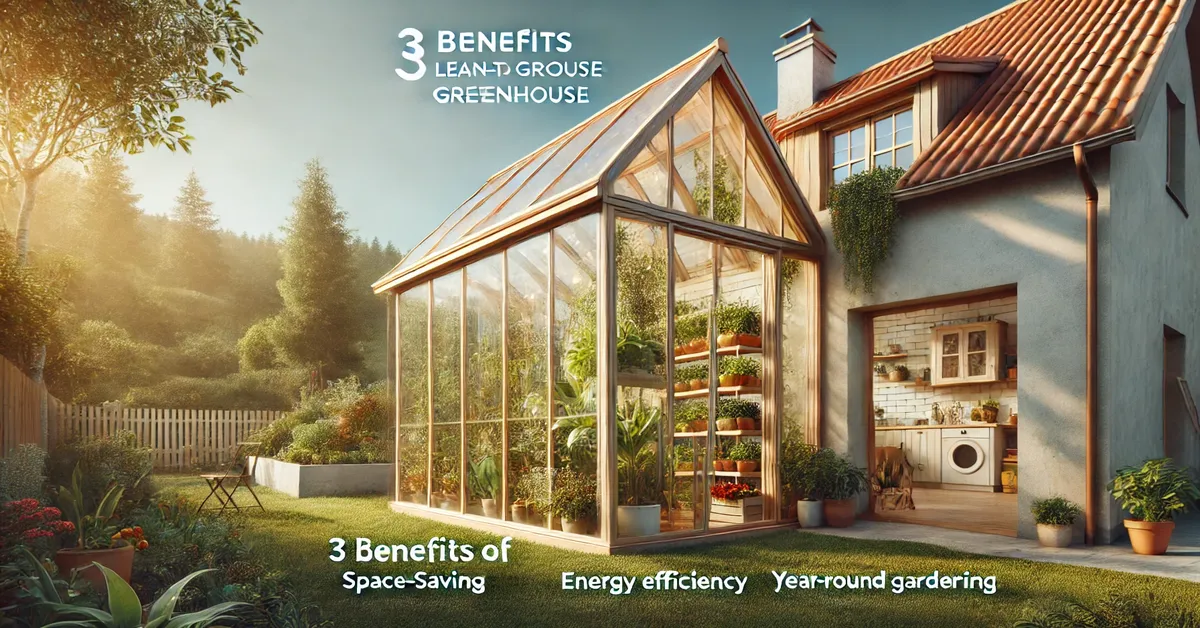For gardening enthusiasts and plant lovers a greenhouse is more than just a structure it’s a sanctuary where plants thrive even in challenging climates. Among the various greenhouse designs the lean-to greenhouse also known as a wall greenhouse has gained popularity due to its practicality cost-efficiency and space-saving qualities.
A lean-to greenhouse is constructed against a sturdy wall of an existing building, making it a versatile option for small spaces or urban settings. This innovative design offers several advantages, allowing gardeners to grow plants year-round while maximizing the utility of their surroundings. This article dives into the 3 key benefits of a lean-to greenhouse, explaining why it’s a smart choice for gardening enthusiasts.
Understanding the Lean-To Greenhouse
What Is a Lean-To Greenhouse?
A lean-to greenhouse is a type of greenhouse structure that leans against a building or wall for support. Unlike freestanding greenhouses, which require space on all sides, a lean-to greenhouse utilizes an existing wall as one of its main supports.
How Does It Work?
By leveraging the wall of a house, garage, or any other sturdy structure, a lean-to greenhouse creates an enclosed space for plants. The greenhouse captures sunlight, retains heat, and provides a controlled environment ideal for growing a wide variety of plants, even in harsh weather conditions.
Why Choose a Lean-To Greenhouse?
Lean-to greenhouses are ideal for gardeners with limited space or those seeking a cost-effective solution. They also integrate seamlessly into urban settings, making gardening accessible to city dwellers.
3 Benefits of Lean-To Greenhouse
Energy Efficiency
One of the standout benefits of a lean-to greenhouse is its ability to conserve energy. By attaching the structure to an existing wall, the greenhouse uses the thermal mass of the wall to maintain stable temperatures inside.
- Reduced Heating Costs: The wall absorbs heat during the day and releases it at night, keeping the greenhouse warm.
- Natural Insulation: Less energy is required to heat the space, making it an eco-friendly option for year-round gardening.
- Protection from Extreme Weather: The wall acts as a barrier against cold winds and provides additional insulation, ensuring plants remain unaffected by fluctuating outdoor temperatures.
Space Efficiency
For gardeners with limited outdoor space, a lean-to greenhouse is a practical solution. Its design maximizes utility without requiring significant land area.
- Compact Design: Lean-to greenhouses fit snugly against walls, making them ideal for patios, balconies, or small backyards.
- Easy Access: Positioned close to a home or facility, it’s convenient to access plants, tools, and supplies without traveling far.
- Customizable Sizes: Lean-to greenhouses come in various sizes, allowing customization based on available space and specific needs.
Cost-Effectiveness
Compared to freestanding greenhouses, a lean-to design is more economical, both in terms of construction and maintenance.
- Reduced Material Costs: By utilizing an existing wall, fewer materials are needed for construction, saving on expenses.
- Lower Maintenance: The sturdy wall provides long-term support, reducing the need for additional structural reinforcements.
- Energy Savings: With better heat retention, lean-to greenhouses are less expensive to operate, especially during colder months.
Additional Benefits of a Lean-To Greenhouse
Year-Round Gardening
A lean-to greenhouse allows you to grow plants throughout the year, regardless of the outdoor weather. From delicate flowers to vegetables, the controlled environment ensures consistent growth.
Aesthetic Appeal
When designed thoughtfully, a lean-to greenhouse can enhance the aesthetic appeal of your home or facility. It creates a seamless integration of greenery and architecture.
Sustainability
Lean-to greenhouses promote sustainable living by enabling local food production and reducing reliance on store-bought produce.
How to Build a Lean-To Greenhouse
Choosing the Right Location
The first step in building a lean-to greenhouse is selecting the ideal wall. A south-facing wall is preferred as it receives maximum sunlight throughout the day.
Materials and Construction
Common materials for lean-to greenhouses include glass, polycarbonate panels, and aluminum frames. Ensure proper sealing and insulation to maintain the internal environment.
Ventilation and Drainage
Proper ventilation prevents overheating and ensures air circulation. Installing a drainage system is crucial to prevent waterlogging and maintain plant health.
Popular Plants for Lean-To Greenhouses
Vegetables
Grow tomatoes, cucumbers, lettuce, and peppers with ease, even during winter months.
Herbs
Herbs like basil, mint, and parsley thrive in the controlled conditions of a lean-to greenhouse.
Flowers
Orchids, geraniums, and succulents are excellent choices for adding color and beauty to your greenhouse.
Tips for Maintaining a Lean-To Greenhouse
- Monitor Temperature: Use a thermostat to ensure plants receive optimal warmth.
- Regular Cleaning: Keep panels clean to maximize sunlight penetration.
- Pest Control: Inspect plants regularly for signs of pests and take preventive measures.
- Watering Schedule: Maintain consistent moisture levels to avoid overwatering or drying out.
Conclusion
A lean-to greenhouse offers a wealth of benefits, making it a practical and efficient solution for gardeners of all levels. Its energy efficiency, space-saving design, and cost-effectiveness set it apart as a versatile option for growing plants year-round. Whether you’re cultivating vegetables, nurturing flowers, or experimenting with herbs, a lean-to greenhouse can transform your gardening experience 3 Benefits of Lean-To Greenhouse.
By leveraging the advantages of an existing wall and embracing sustainable practices, lean-to greenhouses provide a perfect blend of functionality and beauty. Whether you’re a seasoned gardener or a beginner, this type of greenhouse is an investment in both your plants and your passion for gardening.
FAQs
What is a lean-to greenhouse?
A lean-to greenhouse is a structure built against an existing wall, creating a controlled environment for plant growth.
Can a lean-to greenhouse work in small spaces?
Yes, its compact design makes it ideal for small backyards, patios, and balconies.
What materials are best for building a lean-to greenhouse?
Common materials include glass, polycarbonate panels, and aluminum frames for durability and insulation.
Do lean-to greenhouses save energy?
Yes, they utilize the thermal mass of the attached wall to retain heat, reducing energy costs.
What plants thrive in a lean-to greenhouse?
Vegetables like tomatoes, herbs like basil, and flowers like orchids flourish in lean-to greenhouses.
How do I maintain a lean-to greenhouse?
Regular cleaning, temperature monitoring, pest control, and proper watering ensure optimal plant health.







